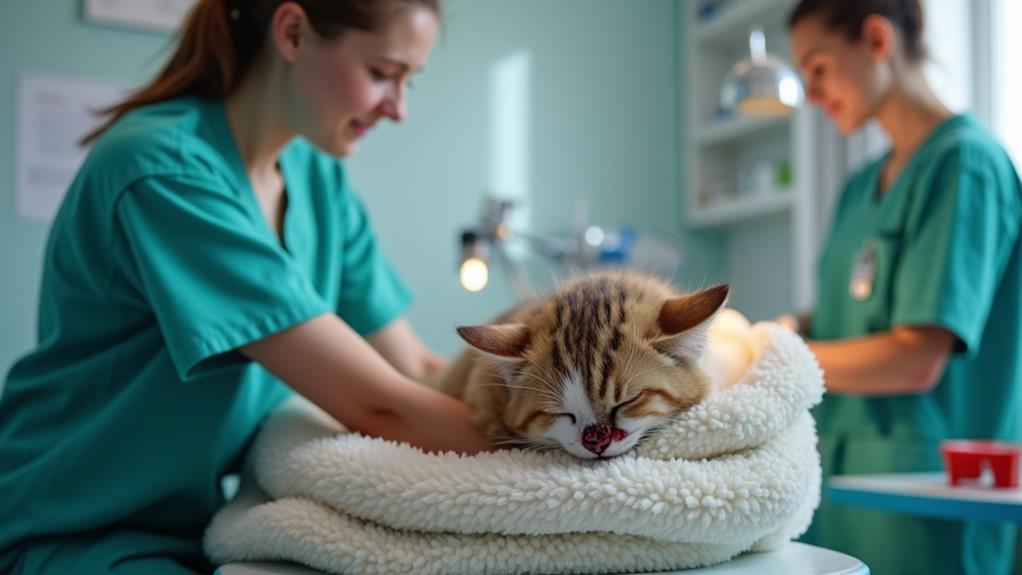How to Help an Injured Feral Cat: A Guide to Rescue and Care

Start by observing the cat for signs of injury like limping or swelling. Use a humane trap, guaranteeing it's placed in a quiet spot to reduce stress. Once captured, get the cat to a vet immediately and provide detailed information on its condition. Post-treatment, create a calm recovery space with a large crate, soft bedding, and minimal noise. Confirm the cat's release point has adequate food and shelter when it's ready to return. Collaborating with local animal welfare groups will further support your efforts. Uncover more about each step to verify the cat's health and comfort thoroughly.
Recognizing Signs of Injury
When you're trying to help an injured feral cat, the initial thing to do is recognize the signs of injury. Look for physical indicators like limping, bleeding, swelling, or visible wounds. These clear markers mean the cat likely needs medical attention. Observing the cat's behavior is essential; signs of distress such as hiding, excessive grooming of a particular area, or persistent vocalizations might indicate an underlying injury.
Watch for any changes in the cat's appetite or drinking habits. A decrease in these can signal pain or illness, suggesting that the feral cat is struggling and may need rescue and care. Lethargy or unusual hiding behavior can also be red flags that the cat is in pain or unwell.
If possible, check for signs of infection, such as discharge or redness around wounds. These symptoms require immediate veterinary care to prevent further complications. Remember, being able to identify these signs is important for the cat's well-being and can make a significant difference in their recovery process. By recognizing these indicators, you're setting the foundation for a successful rescue and ensuring the injured cat gets the help it needs.
Safe Trapping Techniques
To effectively and safely capture an injured feral cat, it is crucial to use humane traps designed specifically for cats, guaranteeing minimal stress and no harm. Set your trap in quiet areas where the feral cat is often seen. This helps reduce stress and enhances the chances of a successful capture. Use bait like fishy canned cat food inside the trap to attract the cat. Once set, cover the trap with a blanket or tarp. This provides shelter and keeps the feral cat calmer by making the environment feel more secure.
Here are some key points to remember:
- Use only humane traps to avoid injury.
- Set traps in quiet areas to minimize stress.
- Cover traps for added security and calmness.
- Check traps frequently to guarantee prompt care.
- Transport safely to a vet using secure traps.
After capturing the cat, confirm you transport it securely to a vet for evaluation and care. Label the trap to communicate any specific needs the cat might have. By following these steps, you contribute considerably to the feral cat's wellbeing and bring it one step closer to receiving the necessary care.
Immediate Veterinary Care

Once you've successfully captured the injured feral cat, it's vital to transport it to a veterinarian without delay. Using humane traps guarantees minimal stress and reduces the risk of further injuries during capture. Upon arrival at the vet, provide detailed observations about any visible injuries, symptoms, or changes in behavior. This information is critical for an accurate diagnosis and appropriate medical treatment plan.
Discuss treatment options and costs with the veterinarian upfront. It's wise to ask about Good Samaritan discounts, which some clinics offer for treating injured feral cats. This can help make necessary medical interventions more affordable.
During the cat's examination, the veterinarian will determine the best course of action. Immediate treatment might include wound care, pain relief, or even surgery, depending on the severity of the injuries. Be prepared to make decisions quickly to guarantee the cat receives timely care.
After the initial medical treatment, make sure you have a plan for post-operative care. Though this guide will cover recovery in detail later, monitoring the cat for any complications post-treatment is vital before considering reintegration into its outdoor environment. Your swift action and care make a significant difference in the feral cat's recovery.
Providing a Safe Recovery
Creating a secure and tranquil environment is essential for the feral cat's recovery. Start by setting up a quiet and safe space using a large dog crate or pet playpen. Limiting movement helps reduce stress and fosters healing from injuries. Guarantee the cat has access to fresh water and high-quality food. Proper nutrition and hydration are fundamental for recovery and will enhance the cat's strength.
To further promote healing, make the recovery area calming. Use soft bedding and minimize noise to create a peaceful atmosphere. Keep an eye on the cat and monitor for any signs of complications, such as excessive bleeding, lethargy, or refusal to eat. Quick action might be necessary, so be ready to contact a veterinarian if any issues arise.
Here are key steps to guarantee a safe recovery:
- Limit movement with a secure crate or playpen.
- Provide fresh water and high-quality food.
- Use soft bedding for a calming environment.
- Monitor for complications and contact a veterinarian if needed.
- Maintain quiet surroundings to minimize stress.
Following these steps will greatly aid the feral cat's recovery, assuring it's ready to return to its environment safely when fully healed.
Returning to Habitat or Sanctuary

After guaranteeing the feral cat's recovery in a safe environment, it's time to focus on returning it to its natural habitat or a suitable sanctuary. Ideally, once the cat has received the necessary medical care, you'll want to return it to its original location. This minimizes stress and respects the cat's territorial instincts. However, if returning to the habitat isn't feasible, consider a safe sanctuary that can provide ongoing care and align with the cat's instinctual needs.
Before release, make sure the site is familiar and offers sufficient food and water sources, along with shelter, to support the cat's reintegration. Once released, it's vital to monitor the cat to confirm it acclimates well. Watch for signs of distress or difficulty adapting to the surroundings.
Collaborate with local TNR groups or animal welfare organizations for support. These groups can assist in establishing a management plan to guarantee the cat's ongoing care. By working with these organizations, you create a network that can help monitor the cat's health and well-being in its original or new environment, facilitating a successful return to the wild.




